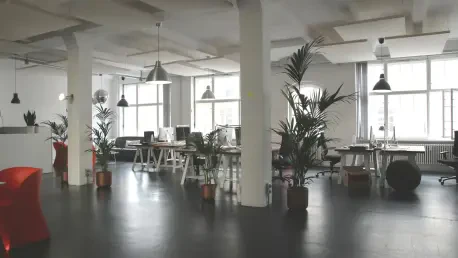The landscape of professional environments has undergone a seismic shift in recent years, with hybrid work models emerging as a cornerstone of modern employment, fundamentally altering how we view and utilize office spaces. Imagine a workforce split between home offices and corporate hubs, where nearly half of employees toggle between these spaces to balance flexibility and collaboration. A recent study surveying over 350 employees across diverse industries in India highlights this transformation, revealing that 47.4% of workers operate in a hybrid setup. This growing trend raises critical questions about the role of physical office spaces in fostering productivity and connection. As businesses grapple with evolving employee expectations, the need to reimagine traditional workplaces has never been more urgent. The focus now lies in creating environments that not only support varied work styles but also nurture a sense of community and well-being, blending the best of both remote and in-office experiences.
Evolving Dynamics of Workplace Models
Shifting Work Arrangements and Preferences
The transition to hybrid work has reshaped how employees engage with their professional environments, creating a spectrum of arrangements tailored to individual and organizational needs. Data from a comprehensive survey indicates that while 42.1% of employees remain fully office-based and 10.5% work entirely from home, a significant 47.4% embrace a hybrid model. This distribution underscores a broader acceptance of flexibility, yet it also reveals a strong inclination toward physical offices for specific purposes. An impressive 77% of new hires and 75% of seasoned staff express a preference for office settings when it comes to collaboration, mentoring, and networking. These statistics point to the enduring value of face-to-face interactions in building relationships and sparking innovation, even as remote work offers undeniable convenience. The challenge for businesses lies in harmonizing these preferences, ensuring that office spaces are not just places to work but hubs of meaningful engagement.
Balancing Flexibility with Physical Presence
Beyond the numbers, the hybrid model exposes a nuanced tension between the freedom of remote work and the structured benefits of office environments. Employees value the autonomy to choose where they work, yet many find that certain tasks—particularly those involving teamwork or creative brainstorming—are best accomplished in person. The physical workplace remains a vital arena for fostering organizational culture and mentorship, elements that are harder to replicate through virtual platforms. However, this balance is not without hurdles, as outdated office designs often fail to accommodate the diverse needs of a hybrid workforce. Noise distractions, cited by 73.7% of respondents as a major issue, exemplify how current spaces can hinder focus and productivity. Addressing this disconnect requires a thoughtful redesign of offices to support both individual concentration and group dynamics, ensuring that physical spaces complement the flexibility of hybrid arrangements rather than conflict with them.
Designing the Future of Office Environments
Crafting Spaces for Diverse Needs
As hybrid work solidifies its place in the professional world, the design of office spaces must evolve to meet a variety of employee expectations and work styles. Research highlights three critical typologies essential for modern workplaces: Immersive Spaces for focused individual tasks, Interactive Spaces for collaborative efforts, and Social Courtyards for community building. A notable 57.9% of employees prioritize dedicated workstations for productivity, while an equal percentage values areas designed for teamwork and learning. Additionally, a striking 84.2% emphasize the importance of social areas for networking and reinforcing cultural ties. Perhaps most telling is that 89.5% of respondents desire offices that mirror the comfort of home, signaling a departure from cold, corporate aesthetics. This shift toward human-centered design suggests that future offices must be adaptive ecosystems, seamlessly blending functionality with warmth to cater to both professional and personal dimensions of work life.
Overcoming Barriers to Adaptation
Despite the clear demand for reimagined workplaces, the pace of adaptation remains alarmingly slow, posing significant challenges to the hybrid work model. Only 29.4% of offices have seen substantial updates in recent years, even as work practices have fundamentally changed. This lag creates friction, with many employees struggling in environments ill-suited to their needs. Noise, identified as a barrier by 73.7% of surveyed individuals, exemplifies how outdated layouts undermine focus and efficiency. The gap between the adoption of hybrid models and the evolution of physical infrastructure highlights a critical oversight in workplace planning. To bridge this divide, organizations must prioritize investments in flexible, technology-integrated spaces that address distractions and support varied work modes. Without such changes, the potential of hybrid work to enhance productivity and satisfaction risks being stifled by environments that fail to keep pace with modern demands.
Pioneering Adaptive and Human-Centric Solutions
Looking back, the journey of hybrid work reflected a profound shift in how workplaces were perceived and utilized, prompting innovative responses to longstanding challenges. Companies took bold steps to integrate technology and human-centric design, crafting offices with quiet zones for deep focus, dynamic areas for collaboration, and inviting social spaces for connection. Plans to expand such initiatives, with growth targets set at 25% for adaptive workspace solutions in the coming fiscal year, demonstrated a commitment to meeting employee needs. These efforts addressed past shortcomings, like the slow redesign of offices, by creating environments that balanced productivity with well-being. As a forward-looking strategy, businesses were encouraged to view offices not just as functional spaces but as ecosystems that evolve with workforce trends. By investing in flexible layouts and prioritizing employee comfort, organizations laid the groundwork for sustainable, engaging workplaces that could adapt to future shifts in professional dynamics.









